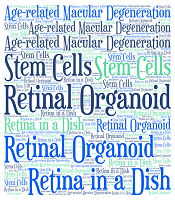Age-related macular degeneration (AMD) is one of the most common diseases leading to irreversible blindness in the elderly. The disease is seen in two forms (dry and wet). In most cases, "dry" AMD contains macular retinal pigment epithelium (RPE atrophy. Also, there is atrophy in the choriocapillary layer and the retina, leading to severe vision loss. In dry AMD, basal RPE deposits such as Dorsen, basal lamina, and basal linear are concentrated in atrophic areas due to cell dysfunction. In geographical atrophy, the choriocapillary becomes thinner, and angiogenesis is inhibited (1, 2). Many laboratories around the world are trying to simulate AMD in the laboratory and find a way to rebuild the entire retina in a dish. Therefore, to design a study on these conditions, some steps must be considered.
The first step in producing the entire retina is to select a stem cell. There are different types of stem cells to differentiate into retinal cells. Induced pluripotent stem cells (iPSCs) and embryonic stem cells (ESCs) are the most promising cells. However, adult stem cells (ASCs) have a high potential to restore vision and protect the retina. A new strategy for producing a complete retina is to use organoids. Studies have shown that hESC or hiPSC cells differentiate into retinal organoids and produce spherical retinoids. Meyer et al. (3) produced spherical retinoids from hESC. In some laboratories, to produce retinoids, stem cells are differentiated into neurospheres (4), and then the culture conditions are changed so that the neurospheres move towards the ocular structures. In this case, these structures, which are in the form of visual vesicles, are like in the embryonic period and become a double-layered cup with an outer and inner layer. The outer layer is pigmented and resembles RPE, but the inner layer is pigment-free and resembles the retina. The inner layer contains retinal progenitor cells that can differentiate into different types of retinal cells.
With the optimization of culture techniques, the structures obtained in the culture have become more similar to embryonic cells. Numerous laboratories are currently studying the differentiation of human stem cells and disease-causing mechanisms, including AMD, using these cell culture models. However, three reasons preclude the use of RPE co-culture models with spherical retinoids. First, there is no anatomical relationship between retinoid structure and spherical RPE. Second, during co-culture, when photoreceptors are maturing in contact with RPE, retinal ganglion cells in the center of the spherical retinoid structure begin to die. Third, the spherical structure of the retinoid has a lumen, the size of the lumen in the retinoid is small, and the release of nutrients to support the cells is impaired. For example, the small lumen in the retinoid prevents retinal ganglion cells from accessing nutrients and spreading (1).
Co-culture of stem cell-derived RPE and RPC: One way to use the co-culture model is to co-culture RPE cells with retinal progenitor cells that are spherical. In this case, RPE secretes nutrients and neuroprotectants for the retina. In the developmental stages of retinal progenitor cells (RPC), as in the embryonic period, RPE and precursor cells and their apical surfaces are in contact with each other. This spherical structure, which is dividing and differentiating to form the retina, must be out of the spherical state and therefore must be separated from the primary neurosphere. This manipulation disrupts close contact between RPE and RPC. During further growth, RPE cell secretions affect RPC cells, causing further differentiation of RPCs. Nevertheless, cellular contact between the retina under construction and RPE is essential. RPE cells only become polarized when they interact with the differentiating apical part of the retina, expressing specific proteins of the apical part. Similarly, the contact of growing retinal cells with RPE cells forms the outer part of the photoreceptors.
Contact with RPE alters the morphological arrangement of photoreceptors in culture. For instance, when in the co-culture model, the RPE cell line (ARPE-19) was added to the culture dish containing the photoreceptors, the ARPE-19 formed a monolayer of RPE on the dish, and the photoreceptors were attached to the apical (free) surface of the RPE and formed their outer part next to RPE. Similarly, in stem cell-derived RPE and RPC co-culture, the time interval of differentiation in both cells plays an important role and should be used in the culture medium (1). RPE cells can be cultured on a variety of surfaces, including porous surfaces of specified sizes. The use of special scaffolding on top of the differentiating RPE layer is a new way to grow RPC. In such scaffolds, secreted paracrine factors are readily available to cells, further differentiating the two cells. With more differentiation of RPE and RPC cells, their secretions also change, and this causes further and better differentiation of these cells. For example, RPE derived from rat ESC compared to human ESC could alter RPC differentiation. Retinal progenitor cells can be differentiated on a specific scaffold. Such scaffolds can form a flat retinoid. The electrical resistance of RPC cultured alone is not significant, but co-culture with RPE cells increases TER by 20 to 100% depending on the stem cell line (1, 5).
Another factor that should be considered for the reconstruction of the entire retina is the correction of the apex of cells. RPE and the adult retina interact in a variety of ways, including the visual cycle and phagocytosis of the outer disc membranes, which are performed daily by photoreceptors. One way to learn and understand the cellular connections between RPE and the retina is to study how they are formed in culture. Some studies have used different strategies to differentiate stem cells into retinal organoids and have used them to study the mechanisms of disease and treatment. RPE secretes various factors that are mainly neurotrophic and affect the retina. Similarly, the growing retina secretes mediators that affect RPE and its maturation. Preliminary studies on RPE of chick embryos have shown that these secretions cause RPE maturation and changes in the expression of its various genes. For example, during the maturation process of RPE cells, 40% of the transcriptome of these cells changed due to contact with the differentiating retina, and the expression of some genes increased or decreased. Today, with hESC and hiPSC cells, it is possible to simulate human growth in a container. Studies show that an RPE sheet can be easily obtained in the laboratory today, but retinal production is a major challenge (1, 6).
Having a proper basement membrane with their proteins is another important factor in the production of a complete retina. The basal layer or Bruch membrane affects the function and behavior of RPE and choroid cells. The Bruch membrane is named after the German anatomist Karl Wilhelm Ludwig Bruch (1844). Bruch membrane is a multilayered structure. RPE is on the inside, and choriocapillaries are on the outside. These five-layer structures are: 1-basal lamina RPE, 2-inner collagen layer, 3-elastic fibers called elastin layer, 4-outer collagen layer, and 5-basal lamina of the choriocapillary. Each layer has a different function despite the different proteins in it and affects RPE and choroid cells. The interaction between the choroid and the BM is central in the construction of the retina during pregnancy.
RPE and choriocapillary act as a single unit, transmitting diffuse and secreted agents through the Bruch membrane. Stem cell culture models can be used to study how the choriocapillary layer and RPE interact with each other. For example, "angiocrine" is a term used to describe the secretion of specific endothelial cells. These secretions preserve tissues. These specific endotheliums provide the microenvironment of stem cells that are essential for tissue repair and regeneration. In a new study by Benedicto et al. cited in Fields et al., assuming that choriocapillaries secrete angiocrine agents and affect RPE, special filters were used to examine angiocrine agents, and cultured hfRPE cells on the filter and choroid endothelial cells were cultured in a plastic container. Increased coagulation between endothelial cells and hfRPE increased TER and diminished paracellular permeability of RPE. This effect appears to be due to the factors secreted by endothelial cells (1).
Tissue engineering and its use in scaffolding is the last step to produce the entire retina in culture medium. The first attempt to create suitable scaffolds was to create gaps on the produced scaffolds, which increased cell proliferation and differentiation. Various natural and synthetic materials were tested to produce scaffolding. Researchers found that RPCs had different responses at different levels. Flat surfaces are not suitable for these cells, and they are not able to attach to them even if the scaffolds are covered with an extracellular matrix. Better results are obtained when the surface of the scaffolding is manipulated with different techniques. For example, ε-polycaprolactone (PCL) can be produced as a flat plate and decorated with short (2.5 μm) or long (27 μm) nanowires. Retinal progenitor cells are morphologically and genetically most distinct when cultured on short nanowire-PCL.
Using PCL engraving to create ridges and linear grooves for mouse RPC amplification as well as differentiation of optical receptors is a good method. Another important factor in scaffold engineering is scaffold rigidity, which alters the cytoskeleton of RPE and RPC and alters gene expression in these cells. By using various manipulations, such as surface topography, chemical modifiers, or mechanical modifiers, differentiation signals can be created that make cells differentiate better. However, such ship systems have drawbacks, including the fact that RPC cells cannot form retinal layers. Recent studies have focused on the differentiation and vertical organization of RPCs to allow the release of nutrients and paracrine agents during differentiation (1).
In sum, focusing on selecting the best stem cell, modifying the apical nature of differentiated cells, decorating the basal lamina, and having interactions, such as the choroid-Bruch membrane, are key to designing a strategy for full retinal production.

